Dr. Ercument Genc is a full-time professor in the Department of Fisheries and Aquaculture Engineering at the Faculty of Agriculture of Ankara University, as well as a member of the National Committee on Registration of Aquatic Genetic Resources since 2014 as an expert in aquatic organisms.
His research has focused on fish, mollusk, and crustacean parasites, as well as fish diseases, nutrition, histomorphology, and DNA barcoding for microbiota analysis.
His main research interests are immun-estimulants, functional food additives, Biofloc technology, liver and intestine histopathology of Finfish and crustacean species, as well as specific health management in aquaculture.


Dr. Genc, you have dedicated your career to exploring problems and solutions for the aquaculture industry. What drove you to “dive” into this fascinating field of research?
The story began with my father giving me an aquarium and a fish as a gift when I finished 3rd grade at primary school. I tried to keep that fish healthy and I ended up entering an Agricultural Engineering undergraduate program in aquaculture.
After graduating from university, I was happy to learn new information every day and share what I learned about aquatic creatures, which led me to get a Master’s Degree and a Doctorate Degree in Aquaculture and Fisheries Science.
I love my job!
![]() The fact that my knowledge and research results attract attention and are used in the industry increases my sense of usefulness, giving me the strength to explore new interesting research questions.
The fact that my knowledge and research results attract attention and are used in the industry increases my sense of usefulness, giving me the strength to explore new interesting research questions.


Who or what inspired you to become who you are today?
During my doctoral courses, I had the opportunity to read about the philosophy and history of science. As you know, humans are curious creatures that seek answers to their questions.
![]() I learned that scientific work is based on research questions, developing hypotheses to solve problems, and predicting how to test the hypothesis.
I learned that scientific work is based on research questions, developing hypotheses to solve problems, and predicting how to test the hypothesis.
I read the publications of very valuable researchers and had the opportunity to work with some of them.
During my undergraduate period, Professor Cemal Taluğ, who worked on expanding our agricultural knowledge and how to share it with the sector in the proper way, became my first idol.
Then, I carried out my Master’s Degree with Veterinarian professor Selçuk Seçer and my doctorate with biologist Professor İbrahim Cengizler.
Meanwhile, I learned a lot from Aquaculturist Dr. Nazmi Tekelioğlu and professor of Medical Pathology, Figen Doran, which made me who I am today.
I learned that you must first have in-depth and extensive knowledge about your specific field in this profession. I am still learning from my students today!

Mycotoxins are a growing concern for the food and feed industry and Climate Change is clearly influencing their patterns of occurrence all around the globe. In the case of aquatic species, which are the most problematic mycotoxins and how do they affect the animals exposed to them?
![]() Indeed, mycotoxins are harmful to aquatic animals, so it is crucial to monitor and control mycotoxin contamination in feed for aquaculture.
Indeed, mycotoxins are harmful to aquatic animals, so it is crucial to monitor and control mycotoxin contamination in feed for aquaculture.
The influence of Climate Change on factors such as temperature and humidity underline the need for ongoing research and adaptable strategies in aquaculture practices.
![]() While more research has been carried out on mycotoxins affecting land animals, concerns about their impact on aquatic species, especially in aquaculture, are growing.
While more research has been carried out on mycotoxins affecting land animals, concerns about their impact on aquatic species, especially in aquaculture, are growing.
The varied effects of mycotoxins on aquatic animals include weakened immunity, organ damage, reproductive problems, and slower growth due to continuous exposure.
 Aflatoxins, produced by Aspergillus flavus and A. parasiticus, are strong carcinogens.
Aflatoxins, produced by Aspergillus flavus and A. parasiticus, are strong carcinogens.-
⇰ In aquatic organisms, they can cause liver issues, leading to slower growth, weakened immunity, and susceptibility to diseases.
 Ochratoxin A, produced by Aspergillus and Penicillium species, can contaminate various feed ingredients, negatively affecting kidney function in aquatic animals, leading to nephrotoxicity.
Ochratoxin A, produced by Aspergillus and Penicillium species, can contaminate various feed ingredients, negatively affecting kidney function in aquatic animals, leading to nephrotoxicity.
 Fumonisins, produced by Fusarium, interfere with lipid metabolism, impacting cell structure and function in aquatic species, potentially causing liver and kidney damage, immune system suppression, and reproductive complications.
Fumonisins, produced by Fusarium, interfere with lipid metabolism, impacting cell structure and function in aquatic species, potentially causing liver and kidney damage, immune system suppression, and reproductive complications. Zearalenone, produced by Fusarium, species, has estrogenic effects, disrupting the reproductive systems of aquatic animals, possibly reducing fertility and impairing reproduction.
Zearalenone, produced by Fusarium, species, has estrogenic effects, disrupting the reproductive systems of aquatic animals, possibly reducing fertility and impairing reproduction.
In addition to these mycotoxins, Fusarium species produce two more that are concerning:
 Enniatins, a group of mycotoxins with ionophoric properties, disrupt ion balance and membrane integrity. In aquatic organisms, exposure to these mycotoxins may lead to cytotoxic effects, affecting cell function and overall health.
Enniatins, a group of mycotoxins with ionophoric properties, disrupt ion balance and membrane integrity. In aquatic organisms, exposure to these mycotoxins may lead to cytotoxic effects, affecting cell function and overall health.
 Beauvericin, another mycotoxin that exhibits cytotoxic, genotoxic, and immunotoxic effects in aquatic species, possibly resulting in organ damage, immune system suppression, and alterations in cellular processes.
Beauvericin, another mycotoxin that exhibits cytotoxic, genotoxic, and immunotoxic effects in aquatic species, possibly resulting in organ damage, immune system suppression, and alterations in cellular processes.


Which are the main signs that should make us include mycotoxicosis in the differential diagnosis and which analysis do you recommend to confirm the diagnosis?
Identifying mycotoxicosis in fish and shrimp poses a challenge due to varied and subtle symptoms. Key signs include:
 Unexplained mortality
Unexplained mortality Reduced feed intake
Reduced feed intake Altered behavior
Altered behavior External lesions
External lesions Gill abnormalities
Gill abnormalities Digestive issues
Digestive issues
Confirmation involves:
 Feed analysis, regularly checking feed for mycotoxin contamination.
Feed analysis, regularly checking feed for mycotoxin contamination. Tissue sampling, examining fish and shrimp tissues for characteristic lesions.
Tissue sampling, examining fish and shrimp tissues for characteristic lesions.
 Toxicological testing through methods such as LC-MS analysis for mycotoxin detection.
Toxicological testing through methods such as LC-MS analysis for mycotoxin detection. Clinical evaluation, collaborating with aquatic veterinarians for a comprehensive assessment.
Clinical evaluation, collaborating with aquatic veterinarians for a comprehensive assessment.

Part of your research has focused on finding strategies to mitigate the impact of mycotoxins on aquatic species. What have you learned throughout the years? We know that there isn’t a magic bullet to prevent mycotoxin exposure so, which are your non-negotiables when it comes to preventing mycotoxicosis?
Over the years, research on mitigating the impact of mycotoxins on aquatic species has revealed valuable strategies.
While there isn’t a universal solution, some common-sense, non-negotiable measures for preventing mycotoxicosis include:
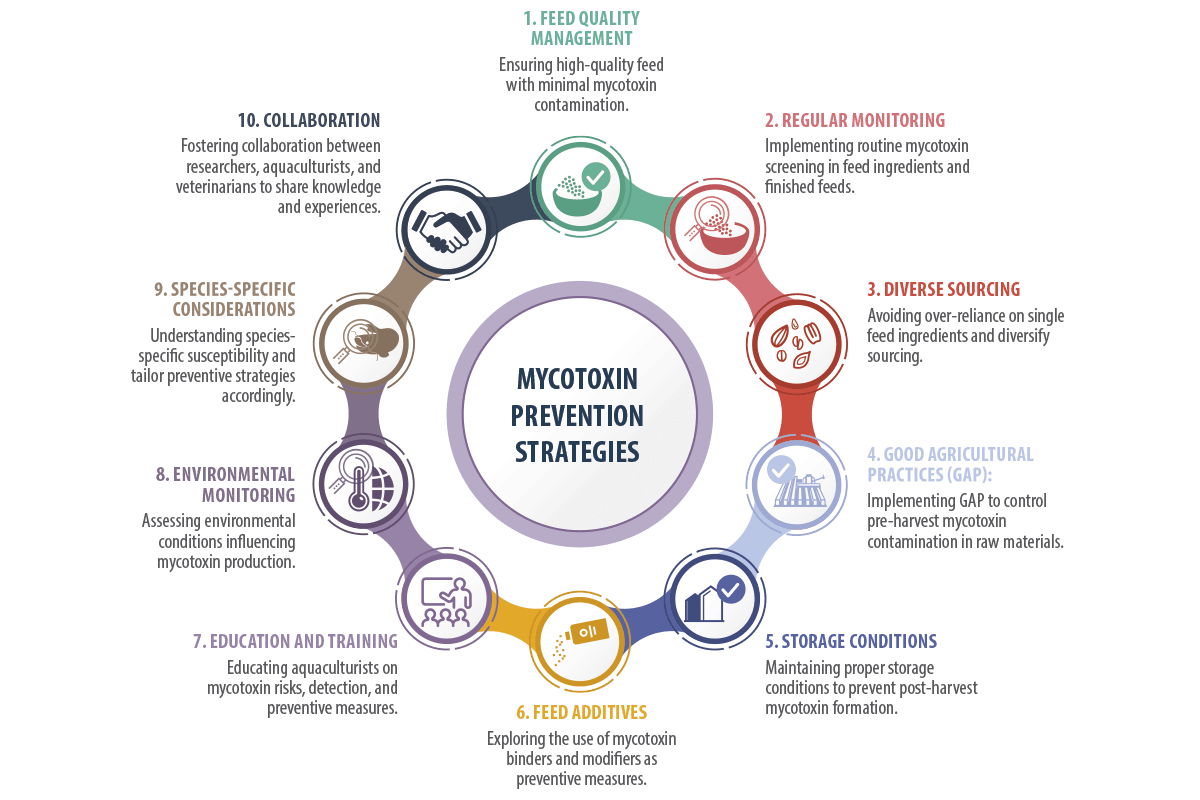


In the last few years, you have been exploring microbiota diversity, a topic that has become familiar as studies reveal the enormous influence the microbiome has on the health of its host. In the case of aquatic species, what do we know? Have you found links between microbiota composition and health or production parameters?
In recent years, scientists have been studying the diverse world of microbiota in aquatic species.
![]() The term “Microbiota” refers to the community of microorganisms that live in and on the bodies of these animals.
The term “Microbiota” refers to the community of microorganisms that live in and on the bodies of these animals.
Here are some key findings from this research:
 Microbiota diversity: fish have a variety of microorganisms on their skin, gills, intestines, and mucus layers.
Microbiota diversity: fish have a variety of microorganisms on their skin, gills, intestines, and mucus layers. The role of the microbiota: these microorganisms play a crucial role in how fish digest food, develop their immune system, and maintain overall health.
The role of the microbiota: these microorganisms play a crucial role in how fish digest food, develop their immune system, and maintain overall health. Disease resistance: a balanced and diverse microbiota seems to help fish resist diseases by preventing harmful pathogens from colonizing them.
Disease resistance: a balanced and diverse microbiota seems to help fish resist diseases by preventing harmful pathogens from colonizing them. Nutrient absorption: the microbiota also aids in breaking down complex compounds, helping fish absorb nutrients from their food.
Nutrient absorption: the microbiota also aids in breaking down complex compounds, helping fish absorb nutrients from their food. Stress response: the composition of microbiota can change when fish are stressed and the microbiota may also affect how fish respond to stress.
Stress response: the composition of microbiota can change when fish are stressed and the microbiota may also affect how fish respond to stress.
 Environmental impact: the environment, particularly water quality, affects the types of microorganisms found in fish. Changes in factors such as temperature or pH can influence these microbial communities.
Environmental impact: the environment, particularly water quality, affects the types of microorganisms found in fish. Changes in factors such as temperature or pH can influence these microbial communities. Gut health and growth: a healthy gut microbiota may contribute to better growth by improving digestion and nutrient absorption.
Gut health and growth: a healthy gut microbiota may contribute to better growth by improving digestion and nutrient absorption. Probiotics in aquaculture: scientists are exploring the use of probiotics, beneficial microorganisms, to improve fish microbiota. Adding specific probiotics to aquaculture systems aims to create a healthy microbial community and enhance overall fish health.
Probiotics in aquaculture: scientists are exploring the use of probiotics, beneficial microorganisms, to improve fish microbiota. Adding specific probiotics to aquaculture systems aims to create a healthy microbial community and enhance overall fish health. Different species – Different microbiota: fish species have different microbiota compositions and understanding these differences is crucial for tailoring aquaculture practices to specific types of fish.
Different species – Different microbiota: fish species have different microbiota compositions and understanding these differences is crucial for tailoring aquaculture practices to specific types of fish. Challenges and opportunities: despite progress, there are still challenges in fully understanding the complex interactions within aquatic microbiota. Ongoing research provides opportunities to develop targeted strategies for improving fish health and sustainability in aquaculture.
Challenges and opportunities: despite progress, there are still challenges in fully understanding the complex interactions within aquatic microbiota. Ongoing research provides opportunities to develop targeted strategies for improving fish health and sustainability in aquaculture.


In your research on fish and shrimp intestinal microbiota you have been using the 16S rRNA processing method. What kind of information does this type of analysis give you? Have you been able to identify beneficial populations that could improve their health, growth, and productivity?
For researching fish and shrimp gut microbiota, scientists often employ the 16S rRNA analysis method.
![]() This sophisticated technique offers a comprehensive insight into the microbial landscape within these aquatic organisms.
This sophisticated technique offers a comprehensive insight into the microbial landscape within these aquatic organisms.
Here is a breakdown of the valuable information derived from this analysis:
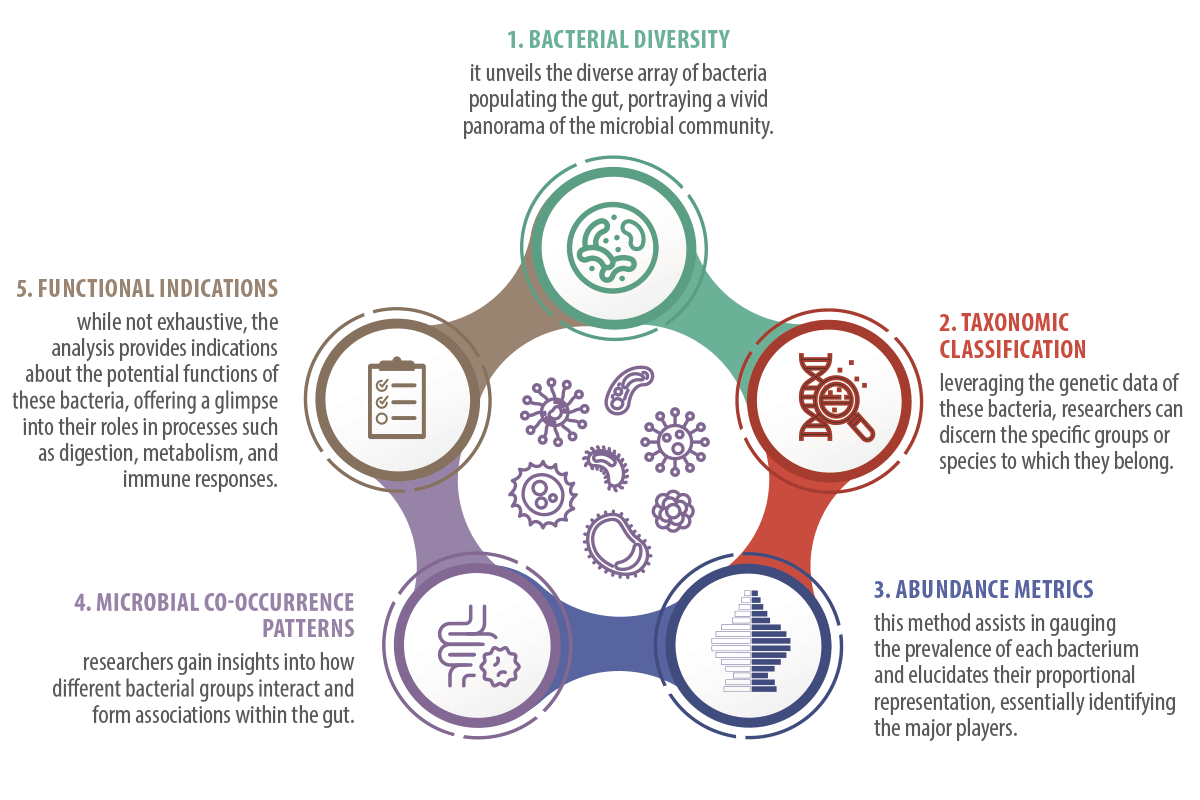
To pinpoint beneficial bacteria, researchers often complement their analysis with tools such as KEGG analysis.
This additional method delves into the functional repertoire of these bacteria, revealing whether they contribute to crucial functions like nutrient processing and energy production.

Among the factors that can alter the balance in the intestinal microbiome, the nutrients in the feed play an important role. Among them, dietary protein is a concern. Why is that?
Various factors can influence the delicate balance of the intestinal microbiome and the nutrients present in the feed are key players in this intricate system.
 This complexity places a significant responsibility on feed manufacturers, who must navigate the challenge of findings the ideal mix of ingredients.
This complexity places a significant responsibility on feed manufacturers, who must navigate the challenge of findings the ideal mix of ingredients.
This balance is not only about minimizing costs, but also ensuring the quality and safety of the final product, and dietary protein stands out as a point of concern.
Protein is a crucial nutrient for aquatic organisms, influencing their growth, development, and overall health. However, the nature of protein presents a challenge.
The breakdown of excess protein can lead to the formation of nitrogenous compounds, such as ammonia and elevated levels can pose a threat to the aquatic environment, potentially harming both the organisms and the delicate equilibrium of the microbiome.
Indeed, the challenge of balancing protein levels and selecting the appropriate protein sources is a complex issue faced by feed manufacturers.
Achieving a balance in supplying necessary nutrients, especially protein, demands a deep comprehension of nutritional and environmental consequences.
The concerns about dietary protein in feed illustrate the fragile equilibrium between promoting ideal aquatic health and lessening potential environmental hazards.
![]() Essentially, discovering the ideal balance becomes a demanding yet crucial undertaking in the field of feed production for aquaculture.
Essentially, discovering the ideal balance becomes a demanding yet crucial undertaking in the field of feed production for aquaculture.


In relation to the topic of optimizing dietary protein in aquafeed, you have been researching the use of Biofloc technology, in aquaculture. Could you briefly explain what Biofloc technology is and why we should find it interesting?
Biofloc technology is an innovative aquaculture technique that promotes the development of microbial communities, primarily composed of bacteria and microalgae, within the aquaculture system.
These microbial communities, known as “bioflocs,” help in nutrient recycling and water quality management. They can also serve as a supplementary feed source, enhancing the overall productivity of the aquaculture system.


Together with Biofloc technology, you have also been looking at the benefits of synbiotics, prebiotics and probiotics. Can all these compounds, including Biofloc technology, be used together as a strategy to promote gut health and prevent mycotoxicosis?
![]() Probiotics are living microorganisms, typically bacteria or yeasts, that provide health benefits when consumed in sufficient amounts.
Probiotics are living microorganisms, typically bacteria or yeasts, that provide health benefits when consumed in sufficient amounts.
In aquaculture, they can positively influence the gut microbiota of aquatic organisms.
 They help balance beneficial bacteria in the digestive tract, enhancing nutrient absorption, and offering protection against harmful pathogens.
They help balance beneficial bacteria in the digestive tract, enhancing nutrient absorption, and offering protection against harmful pathogens. They can be introduced through supplements or naturally in Biofloc systems.
They can be introduced through supplements or naturally in Biofloc systems.
Prebiotics are non-digestible compounds, often fibers or carbohydrates, that support the growth and activity of beneficial microorganisms in the digestive system
 They serve as a food source for beneficial bacteria, stimulating their growth and activity.
They serve as a food source for beneficial bacteria, stimulating their growth and activity. Incorporating them into aquaculture feed can enhance the proliferation of beneficial gut bacteria, contributing to improved gut health.
Incorporating them into aquaculture feed can enhance the proliferation of beneficial gut bacteria, contributing to improved gut health.
![]() Symbiotics are a combination of probiotics and prebiotics, aiming to synergistically promote the growth and activity of beneficial microorganisms in the digestive system.
Symbiotics are a combination of probiotics and prebiotics, aiming to synergistically promote the growth and activity of beneficial microorganisms in the digestive system.
Combining probiotics and prebiotics maximizes the benefits of both, enhancing overall effectiveness in promoting gut health.

In summary, the combination of Biofloc technology with probiotics, prebiotics, and synbiotics offers a comprehensive approach to promoting gut health in aquaculture and mitigating the risks associated with mycotoxicosis.
Ongoing research in this area aims to determine the optimal integration and dosage of these components for effective results in various aquaculture settings.
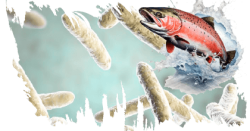

Where do you think we are heading in the future in terms of mycotoxin control and prevention, but also global health management?
In the future, dealing with mycotoxins and taking care of global health will need to focus more on a “One Health” approach.
Here are some important aspects to consider:
![]() Working together for One Health
Working together for One Health
The “One Health” concept refers to understanding how human health, animal health, and the environment are all connected.
Since mycotoxins can affect both animals and humans through food, people are paying more attention to looking at the big picture and considering the health of everything.
![]() Teamwork across different areas
Teamwork across different areas
Dealing with mycotoxins requires people from different areas (farming, animal health, human medicine, environment, and public health) to work together.
This teamwork is important to really understand and manage the risks of mycotoxins.
![]() Better ways to find and monitor mycotoxins
Better ways to find and monitor mycotoxins
Getting better at finding and monitoring mycotoxins is crucial. This includes creating quick and accurate methods to discover mycotoxins in food and animal feed.
This way, we can act fast to stop problems and keep people and animals healthy.
![]() Smart farming and animal feeding
Smart farming and animal feeding
Using smart techniques on farms can help monitor and manage crops to keep mycotoxin levels low. Also, being careful with what we feed animals in farming can reduce the risk of mycotoxins.
![]() Using technologies such as smart sensors and data analysis will become more common for better management.
Using technologies such as smart sensors and data analysis will become more common for better management.
![]() Using helpful microbes, enzymes and feed supplements
Using helpful microbes, enzymes and feed supplements
Scientists are looking into using beneficial microorganisms, enzymes, and feed additives to control mycotoxins.
This way, they hope to reduce how much mycotoxins get into crops, protecting animal and human health.
![]() Teaching and making people aware
Teaching and making people aware
Making sure that people know about mycotoxins, the risks they pose, and how to prevent issues is very important.
This includes teaching farmers, food makers, healthcare workers, and the public about the best ways to farm, process food, and eat to lower the chances of mycotoxin exposure.
![]() Working Together Globally
Working Together Globally
Mycotoxin issues don’t stay in one place, so it’s crucial for different countries to work together.
This includes sharing what we learn from research, following good practices, and having early warning systems for mycotoxin problems to respond well globally.
![]() Dealing with Climate Change
Dealing with Climate Change
The changes in climate can affect how much mycotoxin-causing fungi are around.
Finding ways to adapt to these changes and creating crop types that can handle them will be important for keeping global food safe from mycotoxins.
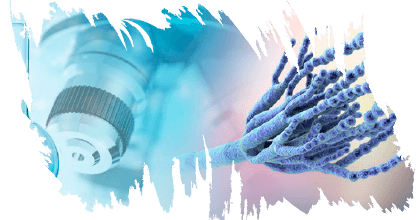

What are your prospects for the future?
As a responsible aquaculturist, looking ahead involves a commitment to sustainability, innovation, and adaptability. Here are some key objectives:
 Sustainable practices: prioritizing eco-friendly methods to minimize environmental impacts.
Sustainable practices: prioritizing eco-friendly methods to minimize environmental impacts. Technological innovation: embracing automation, data analytics, and AI for improved management.
Technological innovation: embracing automation, data analytics, and AI for improved management. Biosecurity measures: implementing strong protocols to manage disease risks and promote health.
Biosecurity measures: implementing strong protocols to manage disease risks and promote health. Adaptation to Climate Change: adjusting practices to cope with climate-related challenges.
Adaptation to Climate Change: adjusting practices to cope with climate-related challenges. Efficient feed management: minimizing waste and environmental impact through smart feed practices.
Efficient feed management: minimizing waste and environmental impact through smart feed practices.
 Consumer awareness: aligning with consumer expectations for sustainable and ethical practices.
Consumer awareness: aligning with consumer expectations for sustainable and ethical practices. Certification and Standards: adhering to recognized standards for environmental and social responsibility.
Certification and Standards: adhering to recognized standards for environmental and social responsibility. Community engagement: collaborating with local communities for mutual benefit.
Community engagement: collaborating with local communities for mutual benefit. Integrated approaches: exploring systems such as aquaponics or IMTA for resource optimization.
Integrated approaches: exploring systems such as aquaponics or IMTA for resource optimization. Continuous research and education: staying informed about “One Health” issues and the latest developments to aid in adaptation, finding the best practices, and addressing challenges and opportunities.
Continuous research and education: staying informed about “One Health” issues and the latest developments to aid in adaptation, finding the best practices, and addressing challenges and opportunities.


For those who would like to follow in your steps or who are thinking about pursuing a career in research, what advice would you give them as we give way to a new generation of scientists looking to make this world a better place through ethical science and technology?
I’ve always liked and followed the words of Jean Jacques Rousseau: “We shouldn’t just teach people science; we should also teach people to enjoy science.”
It would be wonderful if the new generation could highlight the aspects that make science enjoyable when they communicate.
This way, the educators they train in the future can find joy in exploring, take pleasure in learning, feel satisfied in helping others, and experience fulfillment in sharing what they have learned.
In fisheries, where there’s an ethical approach to fishing, the idea is that every living thing should be given at least one chance to reproduce.
![]() In this context, someone who wants to become a researcher should be given the chance to correct their mistake twice under the guidance of their advisor, even if they make a mistake.
In this context, someone who wants to become a researcher should be given the chance to correct their mistake twice under the guidance of their advisor, even if they make a mistake.
When we face a tough situation, it’s important to show strength and determination to bounce back. One thing is certain: Life is short, and we must learn from our own mistakes and the mistakes of others.

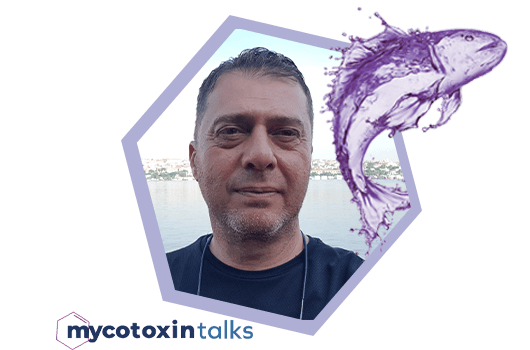



 Micotoxicosis prevention
Micotoxicosis prevention